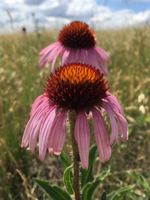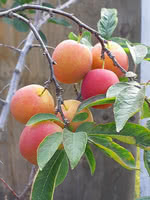Mon-Fri 9am - 5pm Mountain time
Narrow-Leaved Coneflower (Echinacea) vs Patterson Pride Plum
Echinacea angustifolia
Prunus nigra x salicina Patterson Pride
NOT AVAILABLE THIS SEASON - MIGHT RETURN
Narrow-Leaved Coneflower is a native perennial wildflower known for its pink to pale purple, daisy-like blooms. The petals (rays) droop downwards, around a dark, domed center, giving the flower a cone-like appearance. The nectar-rich blossoms attract a wide variety of pollinators, including native bees and butterflies. After flowering, the seeds provide food for birds, further adding to its ecological value.
Once established, it is drought-tolerant due to its deep taproot, which also helps stabilize soil. Narrow-Leaved Coneflower thrives in a variety of well-drained soils, including sandy, rocky, and alkaline. It often grows alongside the native grasses that characterize prairie and grassland ecosystems, making it well-suited for prairie and grassland restoration, naturalization, and pollinator gardens.
The Patterson Pride Plum is known for its delicious flavor, with firm, sweet golden flesh and dark red skin that isn’t sour. The freestone plums can grow 4-5 cm in diameter and are well-suited for fresh eating, baking, and preserves. It can produce heavy yields that ripen in mid-September which is later than other plums.
C.F. Patterson developed the Patterson Pride Plum at the University of Saskatchewan. It is known for its semi-dwarf, weeping growth habit
Patterson Pride Plum is a hybrid between Canada Plum and Japanese Plum. For fruit production, it needs to be planted with another variety for cross-pollination. Canada Plum and American Plum are considered universal pollinizers.

